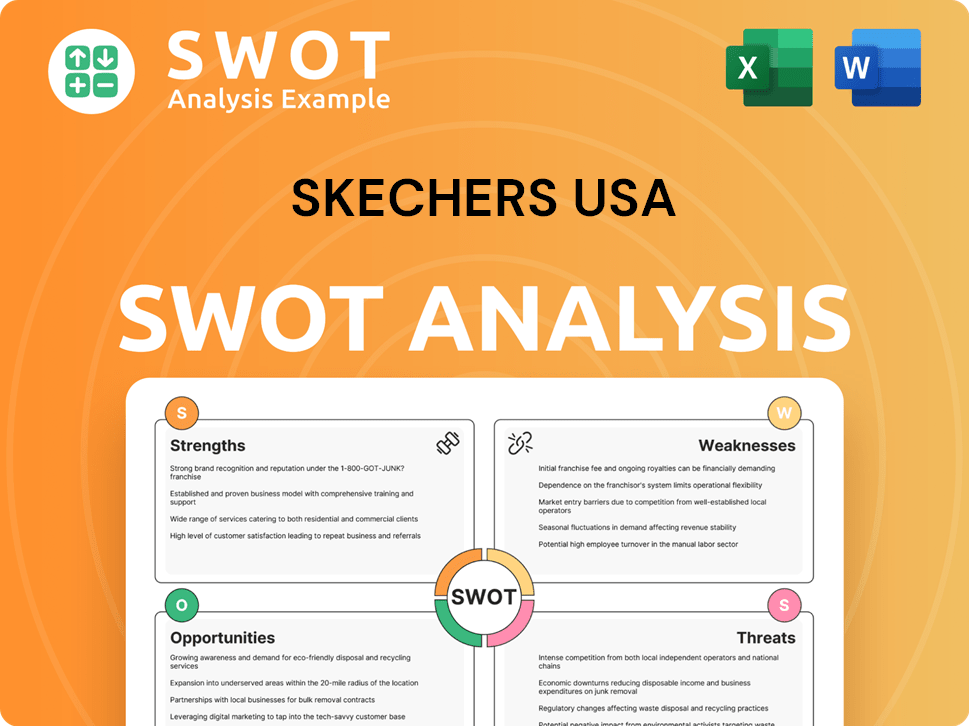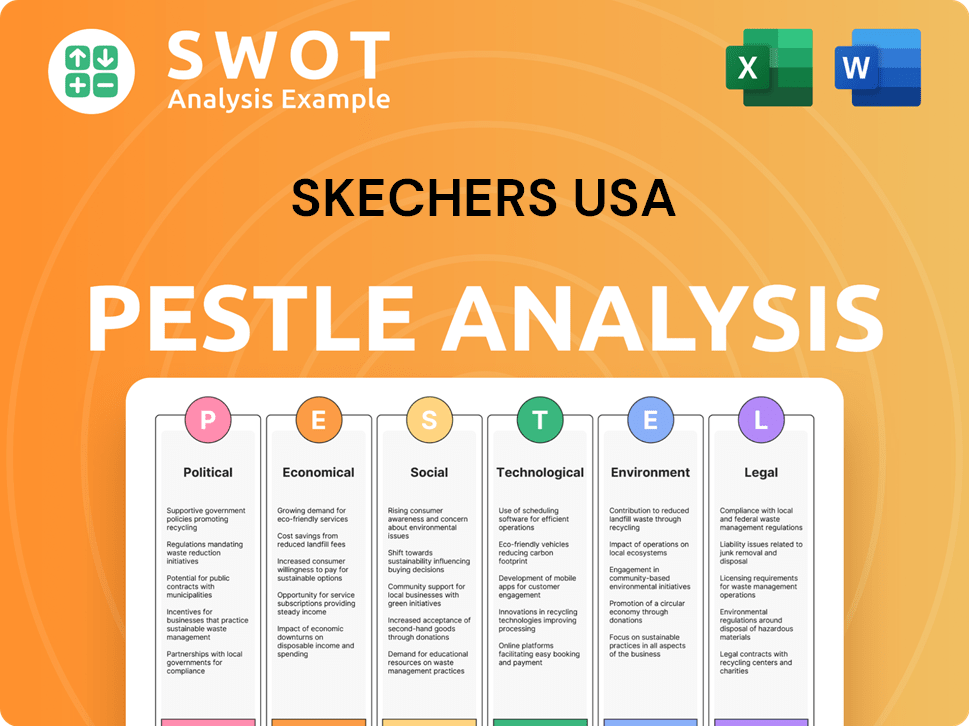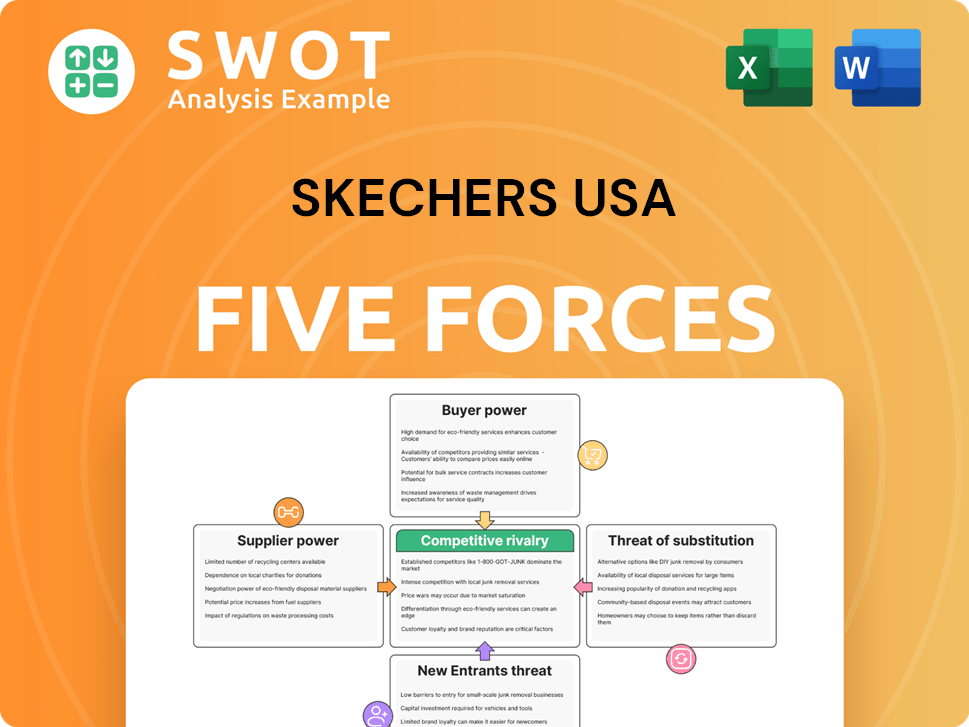Skechers USA Bundle
Can Skechers Outpace Its Footwear Rivals?
In the bustling Skechers USA SWOT Analysis, the company has become a major player, but how does it stack up against the competition? Founded in 1992, Skechers has evolved from a niche provider to a global brand. This analysis dives deep into the Skechers competitive landscape to uncover its strengths and weaknesses.

Understanding the Skechers industry and its position within the broader footwear market is crucial for investors and strategists alike. This report will dissect Skechers competitors, providing a detailed Skechers market analysis that reveals its competitive advantages and challenges. We'll explore the company's financial performance, product offerings, and marketing strategies to offer actionable insights into its future prospects, comparing it to other athletic shoe brands.
Where Does Skechers USA’ Stand in the Current Market?
Skechers USA, Inc. has a strong presence in the global footwear industry. The company is the third-largest footwear company in the United States by revenue. In 2023, Skechers reported record annual sales of $8.00 billion, marking a 7.5% increase year-over-year, showing consistent growth despite economic challenges.
The company's main products include a variety of lifestyle and performance footwear. This includes popular comfort-oriented casual shoes, athletic trainers, sandals, and work footwear. Skechers also offers apparel and accessories to diversify its revenue streams. This diversification helps Skechers maintain a competitive edge in the footwear market.
Skechers has a significant global presence, selling its products in over 180 countries and territories. This is achieved through wholesale partners, direct-to-consumer retail stores, and e-commerce platforms. International sales made up 63% of total sales in 2023. This highlights its global appeal and reduces risk. For more information about the company's ownership, you can check out Owners & Shareholders of Skechers USA.
Skechers holds a strong market position, especially in the United States. It is the third-largest footwear company by revenue. The company's consistent growth and strong financial performance demonstrate its resilience in the footwear market.
Skechers offers a wide range of footwear, including casual shoes, athletic trainers, and work boots. The company also sells apparel and accessories, which helps diversify its product offerings. This broad portfolio caters to a wide range of consumer preferences.
Skechers has a substantial global presence, with sales in over 180 countries. International sales account for a significant portion of its revenue. This global reach helps Skechers to mitigate risks and capitalize on international market opportunities.
Skechers serves a diverse customer base, from children to adults, with a focus on comfort and value. The company has expanded its appeal beyond its initial niche. This broad appeal supports its market share and adaptability.
Skechers' success is built on several key strengths. These include a strong brand, a diverse product portfolio, and a global distribution network. The company's focus on comfort and value resonates with a broad customer base.
- Strong Brand Recognition: Skechers has built a strong brand image.
- Diverse Product Line: Offers a wide variety of footwear and apparel.
- Global Distribution: Products are sold in over 180 countries.
- Customer Focus: Emphasis on comfort, style, and value.
Skechers USA SWOT Analysis
- Complete SWOT Breakdown
- Fully Customizable
- Editable in Excel & Word
- Professional Formatting
- Investor-Ready Format

Who Are the Main Competitors Challenging Skechers USA?
The Skechers competitive landscape is characterized by intense rivalry within the global footwear and apparel market. The company faces both direct and indirect competition, requiring it to continually innovate and adapt to maintain its market position. Understanding the dynamics of its competitors is crucial for Skechers market analysis and strategic planning.
The Skechers industry is influenced by consumer preferences, technological advancements, and economic conditions, all of which shape the competitive environment. The company's ability to navigate these factors will determine its success in a dynamic market, as highlighted in a Brief History of Skechers USA.
Skechers competitors include a mix of established multinational corporations and emerging brands, each employing different strategies to capture market share.
Nike is a dominant player in the athletic footwear market, posing a significant challenge to Skechers. Nike's brand recognition and extensive product offerings across various categories give it a competitive edge. In 2024, Nike reported revenues of approximately $51.2 billion.
Adidas competes strongly with Skechers, especially in performance footwear and fashion collaborations. Adidas has a strong global presence, particularly in key international markets. Adidas's revenue in 2024 was around $21.4 billion.
Deckers Brands, specifically with its Hoka brand, presents a growing challenge in the performance running and comfort footwear segments. Hoka has gained significant traction for its maximalist cushioning. Deckers Brands reported net sales of $4.3 billion in fiscal year 2024.
Crocs competes in the casual and comfort footwear space, known for its distinctive clogs. Crocs has been expanding its market share in casual wear. Crocs' revenue in 2024 was approximately $3.96 billion.
Private-label brands offered by large retailers also pose indirect competition. These brands often provide lower-priced alternatives. The market share of private-label brands varies but remains a significant factor.
New, digitally native brands that leverage social media and direct-to-consumer models also compete. These brands can rapidly capture niche markets. The growth of these brands is a notable trend in the footwear market.
Skechers USA company competitive advantages include its diverse product line, strong brand recognition, and global distribution network. Skechers differentiates itself through comfort-focused designs and strategic marketing. Competitive strategies of Skechers involve product innovation, expanding retail presence, and digital marketing efforts.
- Product Innovation: Continuously introducing new designs and technologies to meet changing consumer preferences.
- Marketing and Branding: Investing in marketing campaigns to enhance brand awareness and customer loyalty.
- Distribution Network: Expanding its retail footprint and online presence to reach a wider audience.
- Cost Management: Efficiently managing costs to maintain competitive pricing.
- Global Expansion: Targeting international markets for growth.
Skechers USA PESTLE Analysis
- Covers All 6 PESTLE Categories
- No Research Needed – Save Hours of Work
- Built by Experts, Trusted by Consultants
- Instant Download, Ready to Use
- 100% Editable, Fully Customizable

What Gives Skechers USA a Competitive Edge Over Its Rivals?
Understanding the Skechers competitive landscape involves recognizing its core strengths. The company has carved out a significant position in the footwear market by focusing on comfort, accessible pricing, and a broad product range. This strategic approach, combined with a robust global distribution network, allows it to compete effectively against both athletic shoe brands and broader lifestyle brands.
Key to Skechers competitive advantages are its proprietary comfort technologies, such as Memory Foam and Arch Fit. These innovations resonate with consumers prioritizing comfort. Furthermore, Skechers' ability to quickly adapt to market trends and its efficient supply chain contribute to its sustained competitive edge. A deep dive into Skechers market analysis reveals how these factors have shaped its market position.
The company's success is also driven by its effective marketing strategies, including celebrity endorsements, which enhance brand appeal across diverse demographics. Skechers consistently leverages its comfort-centric approach and efficient operations to maintain its competitive edge against rivals in the dynamic Skechers industry.
Skechers USA company competitive advantages are significantly enhanced by its proprietary comfort technologies. These technologies, including Memory Foam, Arch Fit, and Skechers Max Cushioning, are key differentiators. This focus on comfort has allowed the brand to attract a broad consumer base.
Skechers strategically positions itself with accessible pricing. This allows it to capture a significant share of the mass market, especially when compared to premium athletic brands. This strategy has been instrumental in driving sales and market share growth.
A highly diversified product portfolio is a core strength. Skechers offers a wide range of footwear styles, catering to various consumer needs and preferences. This diversification helps mitigate risks and capture a broader market segment.
Skechers boasts an extensive global distribution network. This includes wholesale, company-owned retail stores, and e-commerce. This broad reach ensures accessibility for consumers worldwide, supporting strong sales and brand visibility.
Skechers differentiates itself through its focus on comfort, which is a primary driver of consumer preference. Its ability to offer innovative comfort features at accessible price points is a significant advantage. This strategy has been successful in the footwear market.
- Proprietary Comfort Technologies: Memory Foam, Arch Fit, and Max Cushioning.
- Accessible Pricing: Positioned competitively against premium brands.
- Rapid Design-to-Market: Quick response to fashion trends.
- Global Distribution: Extensive wholesale, retail, and e-commerce presence.
Skechers USA Business Model Canvas
- Complete 9-Block Business Model Canvas
- Effortlessly Communicate Your Business Strategy
- Investor-Ready BMC Format
- 100% Editable and Customizable
- Clear and Structured Layout

What Industry Trends Are Reshaping Skechers USA’s Competitive Landscape?
The footwear industry is experiencing significant shifts, with sustainability, e-commerce, and consumer health and wellness trends reshaping the Skechers competitive landscape. These trends present both challenges and opportunities for the company. Understanding the current market dynamics and anticipating future changes is crucial for Skechers market analysis and strategic planning to maintain its position in the footwear market.
Skechers faces intense competition from established players and emerging direct-to-consumer brands, requiring continuous innovation and adaptability. Economic fluctuations and supply chain disruptions pose additional risks. However, opportunities exist in expanding into new markets, developing specialized product lines, and leveraging technological advancements, potentially solidifying its future outlook.
Consumers are increasingly demanding sustainable products, pushing companies to adopt eco-friendly practices. This involves using sustainable materials and manufacturing processes. Skechers needs to invest in these areas to meet consumer expectations and comply with stricter regulations.
The rise of e-commerce necessitates continuous investment in digital infrastructure and online marketing. Maintaining a strong online presence and offering seamless omnichannel experiences is crucial. Skechers must compete effectively with digitally native brands and e-commerce giants.
Growing consumer focus on health and wellness aligns well with Skechers' performance and comfort footwear. This trend offers a significant growth opportunity. The company can capitalize on this by innovating its performance lines and expanding in athletic and outdoor categories.
The footwear market is highly competitive, with established brands and direct-to-consumer brands vying for market share. Skechers faces pressure from competitors like Nike and Adidas. Maintaining a competitive edge requires continuous innovation and effective marketing strategies.
Skechers can expand into underserved emerging markets and develop specialized product lines. Leveraging advancements in footwear technology, such as 3D printing, offers further opportunities. Strategic initiatives are essential for sustained growth.
- Product Innovation: Continuously develop new and improved footwear designs and technologies to meet evolving consumer preferences and needs.
- International Expansion: Focus on expanding its presence in high-growth international markets to diversify revenue streams and increase market share.
- Direct-to-Consumer Channels: Enhance its direct-to-consumer channels, including e-commerce and retail stores, to improve customer experience and control over brand messaging.
- Marketing and Branding: Invest in marketing and branding efforts to increase brand awareness and customer loyalty, highlighting its unique value proposition in the market. To learn more about Skechers' marketing strategies, you can read this article: Marketing Strategy of Skechers USA.
Skechers USA Porter's Five Forces Analysis
- Covers All 5 Competitive Forces in Detail
- Structured for Consultants, Students, and Founders
- 100% Editable in Microsoft Word & Excel
- Instant Digital Download – Use Immediately
- Compatible with Mac & PC – Fully Unlocked

Related Blogs
- What are Mission Vision & Core Values of Skechers USA Company?
- What is Growth Strategy and Future Prospects of Skechers USA Company?
- How Does Skechers USA Company Work?
- What is Sales and Marketing Strategy of Skechers USA Company?
- What is Brief History of Skechers USA Company?
- Who Owns Skechers USA Company?
- What is Customer Demographics and Target Market of Skechers USA Company?
Disclaimer
All information, articles, and product details provided on this website are for general informational and educational purposes only. We do not claim any ownership over, nor do we intend to infringe upon, any trademarks, copyrights, logos, brand names, or other intellectual property mentioned or depicted on this site. Such intellectual property remains the property of its respective owners, and any references here are made solely for identification or informational purposes, without implying any affiliation, endorsement, or partnership.
We make no representations or warranties, express or implied, regarding the accuracy, completeness, or suitability of any content or products presented. Nothing on this website should be construed as legal, tax, investment, financial, medical, or other professional advice. In addition, no part of this site—including articles or product references—constitutes a solicitation, recommendation, endorsement, advertisement, or offer to buy or sell any securities, franchises, or other financial instruments, particularly in jurisdictions where such activity would be unlawful.
All content is of a general nature and may not address the specific circumstances of any individual or entity. It is not a substitute for professional advice or services. Any actions you take based on the information provided here are strictly at your own risk. You accept full responsibility for any decisions or outcomes arising from your use of this website and agree to release us from any liability in connection with your use of, or reliance upon, the content or products found herein.